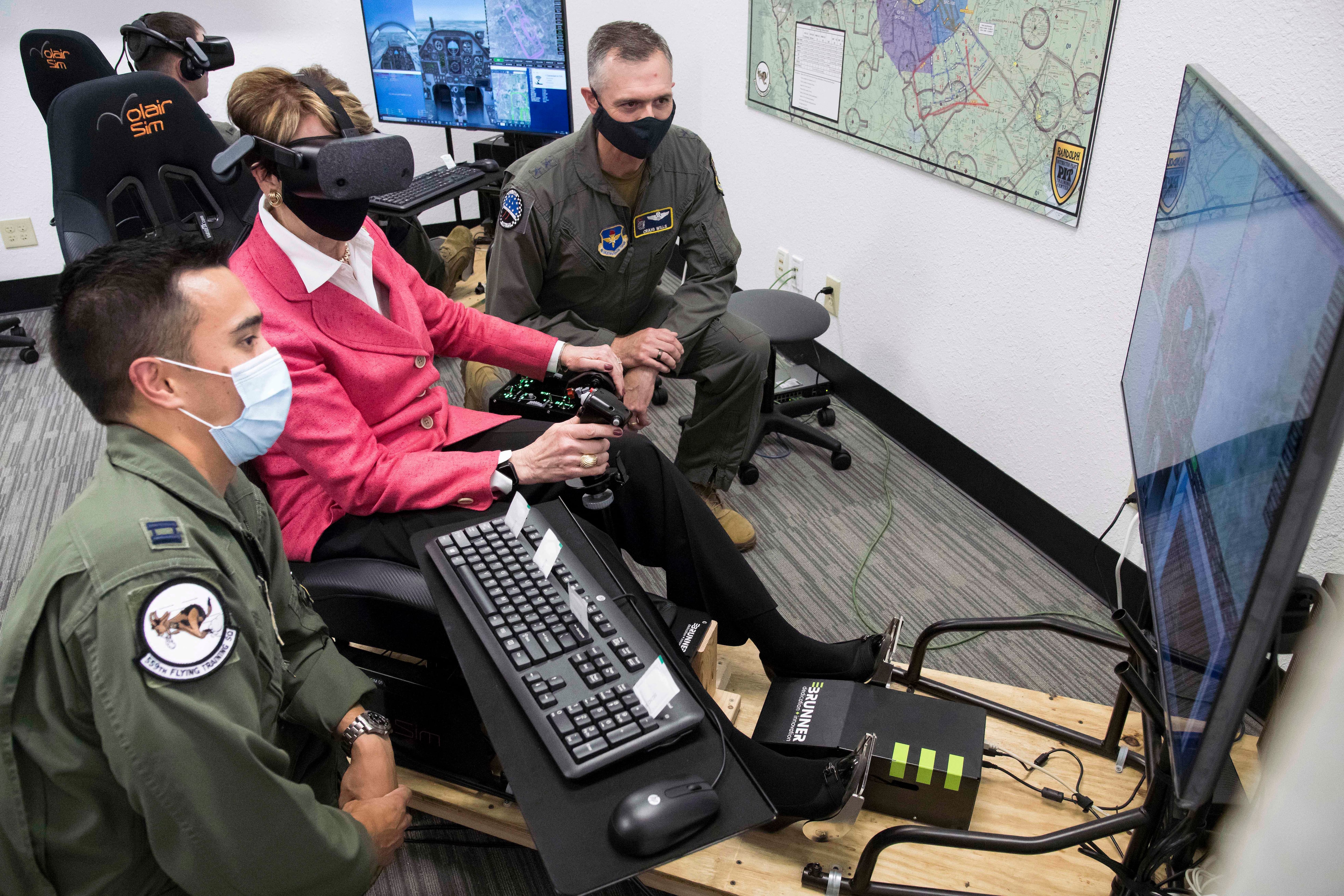The Air Force says its new approach to pilot training, which uses digital learning to complement hands-on practice, is the way of the future. The service also hopes it will help keep airmen safe in the cockpit.
Air Education and Training Command has rolled out a slate of pilot education initiatives that look to boost students’ knowledge with more simulator time, speed the time it takes to earn wings, and broaden the pool of competent candidates — without jeopardizing the force’s rigorous standards for pilot qualification.
“A lot of the things that we’re doing with [Undergraduate Pilot Training] 2.5 are actually going to make a better pilot,” Maj. Gen. Craig Wills, who oversees flight training as commander of 19th Air Force, told reporters Tuesday. “We’re not trying to make pilot training easier. What we’re trying to do is actually challenge our students better from day one.”
That comes as Air Force Chief of Staff Gen. Charles “CQ” Brown — a longtime fighter pilot himself — argues training needs to get “back to basics” to build proficiency in takeoff and landing. About 30 of the 72 Class A and B mishaps that occurred last year involved problems in those fundamental stages of flight, Air Force Magazine previously reported.
Seven airmen died in aviation-related accidents in fiscal 2020, according to service data. The Air Force saw 23 of the most severe manned aviation mishaps, known as “Class A,” in 2020, or about 1.5 accidents per 100,000 flight hours. That’s the second-highest annual rate since at least 2011, according to Air Force figures provided to Congress this week.
Testifying before the House Armed Services readiness subcommittee Tuesday, Air Force Vice Chief of Staff Gen. David Allvin praised the use of virtual and augmented reality and other technology that drive the service’s modernized training. Students can take VR systems home to spend hundreds of extra hours learning their way around an airplane, and call up on-demand videos on a tablet to learn at their own speed.
“This technology differs from traditional approaches in that it enables students a much more immersive training experience, which significantly increases the quality of their training,” Allvin said in written testimony. “Because students require less direct instructor support, they are able to more readily tailor their training to address their unique gaps and work asynchronously, accelerating the training process.”
Scaling up the use of that technology across the training enterprise will come “with a keen eye toward flying safety risk,” he added.
The Air Force graduated 1,263 pilots last year and is aiming to reach 1,500 pilots per year by 2024. Just a fraction of those have gone through the modernized program so far.
Undergraduate Pilot Training 2.5 is one of the Air Force’s main initiatives to overhaul how the typical airman learns to fly a plane, following an earlier tech-centered project called Pilot Training Next. The first 10 students graduated from the seven-month UPT 2.5 program March 19.
The service will crunch data to determine whether these new undergraduate cohorts are performing better than students who went through earlier versions of pilot school. Part of the calculus is seeing how airmen handle unexpected situations.
Pilot Training Next, a predecessor to UPT 2.5, yielded graduates who fare better in the most advanced jets, like the F-35 Lightning II, than in older models. Wills said that in general, those trainees have “met the standard and moved on” alongside airmen in a different program.
“We’re trying to introduce more complex scenarios,” Wills said. “We’re trying to drive scenarios that cause them to rethink and replan, and to be more flexible throughout.”
Wills believes the approach is right on track. But the emerging challenge of trying out a new method is deciding how students should juggle real-life flying hours, time in a simulator, and academic lessons. Striking the right balance will give airmen enough experience to be both effective and safe in the cockpit.
“We’re pulling all of the grade sheets and we’re reviewing all those things,” Wills said. “Our No. 1 priority is to produce a pilot that’s going to be safe and lethal. There’s no intent to cut any kind of a corner.”
The two-star general cautioned against drawing a direct correlation between the number of flight hours a pilot has logged in training and the likelihood of an accident, saying each mishap occurs under unique circumstances.
Changes to introductory flight training in Pueblo, Colo., could also help strengthen the fundamentals as Brown wants.
The Air Force is looking at expanding its initial flight training program so young airmen can get a firmer grasp of concepts like basic navigation and cockpit instrumentation, Wills said. Doubling that program from 25 hours to 50 hours can better prepare trainees for more advanced planes like the T-6, which readies students to fly bombers, fighters, airlifters or tankers.
“We should be looking at a student that has a higher baseline from which we can train them to an even higher level, which we’re excited about,” Wills said, noting it can also increase diversity among candidates who may not have had access to flight school before joining the Air Force.
“We think the opportunity to better prepare all of our candidates for flight training is good for everybody,” he said.
Rachel Cohen is the editor of Air Force Times. She joined the publication as its senior reporter in March 2021. Her work has appeared in the Washington Post, the Frederick News-Post (Md.), Air and Space Forces Magazine, Inside Defense, Inside Health Policy and elsewhere.





